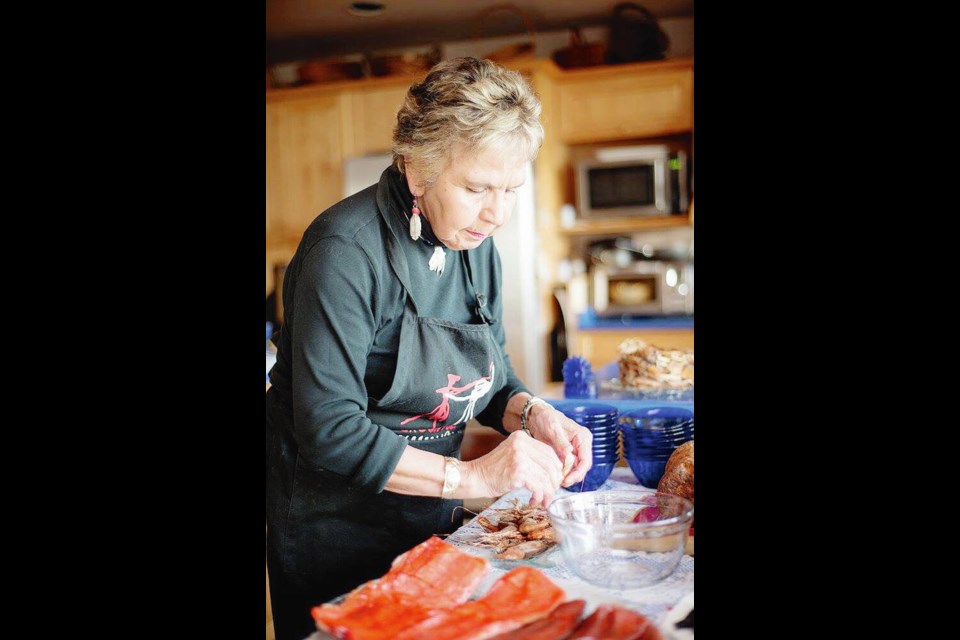A painting of totems at an ancient village on Haida Gwaii that hung in a Victoria hotel for more than four decades has made it back to the artist and her family.
Nobody is sure how the Chateau Victoria came into possession of the artwork by Keenawaii Roberta Olson, but it was likely acquired at a 1980 exhibition where Olson, a Haida artist with a growing profile, displayed about 30 of her works at a downtown gallery.
When the hotel started a refresh of its interiors this year, Rory Perron of Local Liquidators was hired to remove several items of furniture and art. He was intrigued by the totem painting and an old Times Colonist article about the artist and her show, and was surprised when he was able to track down the artist.
“That was a long time ago, and I haven’t painted for a long time … now I invite people into my home and cook for them,” Olson said in an interview. She’s now 83 and operates Keenawaii’s Kitchen in Skidegate on Haida Gwaii where she uses an artistic touch on her unique Haida seafood dishes.
After she received a surprise call from Perron, she put him in touch with her granddaughter, Elisha Henderson, in Victoria who gladly took possession of the painting.
Perron said after getting in touch with Olson and showing her pictures of the piece, she offered to buy the painting. But Perron thought it should go back to the person who so gracefully brought the totems to life.
“Many of my favourite experiences in this business are sometimes about giving items away for free or giving them back to where they came from — and this was very special,” said Perron. “She’s an amazing lady, and the great thing is it’s going back to her family.”
Olson said she probably painted the totems in 1979 at UNESCO World Heritage Site SGang Gwaay, also known as Anthony Island, and it was a special place for her family and the spot she was inspired to be an artist at an early age.
“We spent a lot of time there,” said Olson. “We found a glass fishing ball when I was young and I was going to get somebody to paint it. I asked my mom about that and she just said paint it yourself. I guess that’s when I started to paint.”
Olson attended Skidegate school and the residential school at Alert Bay on Vancouver Island. She was inspired by the art of the Haida through her uncle, famed carver Rufus Moody, and grandfather Albert Jones, who taught her the legends of the Haida Nation.
She lived in in Tofino, Duncan and Qualicum and dabbled in her own oil painting techniques, including the textures that gave age and weathering to the totem poles in her works.
Henderson, one of Olson’s many grandchildren, is perhaps the largest collector of her grandmother’s art. She has several paintings, glass fishing floats, beaded eagle feathers and pottery teapots her grandmother shaped, fired and painted over the years.
“My nanaay [grandmother in Haida] is a very special person,” said Henderson. “She’s amazing. She works hard and she always shares her knowledge.”
“She even took me to the Golden Spruce before it was cut down.”
The giant sitka spruce along the banks of the Yakoun River was unique and striking. It had a rare genetic mutation that gave it golden needles and it was known by the Haida people as Kiid K’iiyas. It had been a sacred part of the culture’s oral history for generations.
In 1997, the 300-year-old was cut at the base by a misguided timber scout in an act of protest, which was the subject of a book entitled the Golden Spruce. The tree fell a few days later in a big wind.
Henderson, 44, said she grew up in a family of painters, carvers and jewelry makers who proudly tell the Haida stories, which she is happy to teach her own three daughters.
She said her grandmother’s Haida name, Keenawaii, means “heavy presence,” which suits her well.
“She has a special aura and she has been entertaining all her life,” said Henderson.
Her grandmother also helped to cook, feed and support the tense Haida blockade of logging on Gwaii Haanas, standing their ground and protecting 1,500 square kilometres for a national park preserve.
“Growing up there, she would show us how to live off the land, picking berries and plants and catching crabs in the low tides,” said Henderson. “I would work for her in the kitchen growing up.”
Olson said she is happy to cook and create First Nations dishes now using deer, octopus, salmon, herring roe, seaweed and other ingredients from her Haida territory.
“To paint you really have to be alone,” she said, noting her life is too busy and fulfilling.
Henderson said the “found” painting by her grandmother is extra special because it was likely painted during the year of Henderson’s birth.



